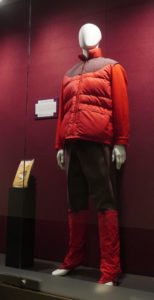Story by Megan Osborne

During the 1960s the United States witnessed a meteoric rise in the popularity of outdoor recreation pursuits such as backpacking, mountaineering, and winter sports. Companies such as The North Face were formed to sell specialized gear to the new outdoor enthusiasts. However, these “performance products” that could withstand the elements were not inexpensive. A man named Dale Johnson recognized a niche in the market and set out to provide outdoor gear at an accessible price point.
Johnson founded Frostline, a Boulder, Colorado-based company in 1966. The core business of Frostline was the production and sale of sew-it-yourself outdoor gear kits. Their merchandising included the slogan “the kits made in America. by everyone.” and the product line included items from tents and sleeping bags to clothing and backpacks. The cost savings to the consumer was in the do-it-yourself at home construction model. A Frostline kit came with all the component parts needed to construct the item – they were pre-cut, no patterns or cutting involved.
By many accounts, the kits were very easy to assemble, even for the novice stitcher. Frostline even developed a new way to package the down filling so that it was manageable for the home sewer.
High quality materials
This red and green down vest, the gaiters, and the unopened kit were purchased in 1970, right at the height of Frostline’s popularity. Former CSU professor emeritus and veterinary surgeon Jim Ingram (1925-2019) constructed the vest and gaiters, doing all the sewing himself. Frostline kits were made from high-quality materials and many garments constructed from their product line still survive.
From its mid-1960s mail-order company origins, Frostline grew to include eighteen retail stores by 1978 before it was bought by The Gillette Company. Under the new management, Frostline’s business began to decline, and it was eventually liquidated by Gillette in 1983. InSport bought the Frostline name in 1984 and resumed sales of the kits until it shuttered its doors in 2000. Many people believe the rise in offshore manufacturing and imported goods coupled with the decline in home sewing contributed to the final closing of Frostline. Original Frostline kits can still be found on eBay and Etsy.
Avenir Museum Permanent Collection #2020.07.02 A B C D
The Avenir Museum is in the Department of Design and Merchandising, part of CSU’s College of Health and Human Sciences.